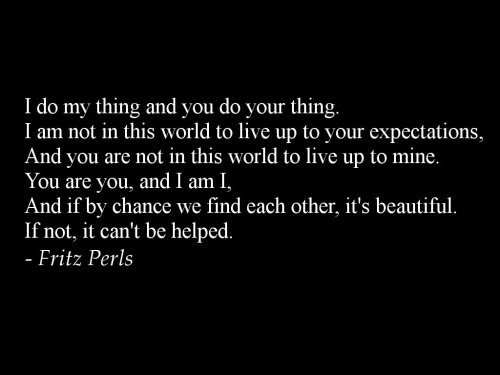Founders: Fritz Perls (1893-1970), Laura Posner Perls (1905-1990)
(terrigalgestalt.com)
Key Concepts: Concentrating on the here and now; Gestalt Therapy is an existential, phenomenological process based approach with awareness, choice, and responsibility of the individuals environment being most important (Corey,2009). Relational Gestalt therapy concentrates on dialogue between client and therapist. Unlike Freud's view on humans being mechanistic, Perls views stressed an holistic approach and the present not the past is examined (Corey,2009).
Relations: Emotion-focused therapy (EFT), developed by Leslie Greenburg (2011) entails the practice of therapy being informed by understanding the role of emotion in psychotherapeutic change. Change is the big key here with such similar approaches as existential, person-centered, and Gestalt theropies. EFT is based on empirical (actual observation) research which Gestalt is not.
Therapeutic Goals: According to Corey (2009), the six methodological components that are most important are as follows:
- the continuum of experience
- the here and now
- the paradoxical theory of change
- the experiment
- the authentic encounter
- and process-oriented diagnosis
- Move toward increased awareness of themselves
- Gradually assume ownership of their experience (as oppesed to making others responsible for what they are thinking, feeling, and doing)
- Develop skills and acquire values that will allow them to satisfy their needs with-out violating the rights of others
- Become more aware of all of their senses
- Learn to accept responsibility for what they do, including accepting the consequences of their actions
- Be able to ask for and get help from others and be able to give to others
Youtube has a two part series of Dr.Perls and his client Gloria. Where he liked to get the client upset as apart of his therapy is very obvious in the following video... watch both parts if you have time.
(Ager, 2011)This following video is how Gestalt Therapy is used in current day and the use of the empty chair technique...
Resources
A, D. (2009). Gestalt therapy - the empty chair technique [Web]. Retrieved from http://www.youtube.com/watch?v=tSU1UiqBii
Ager, R. (2011). Gestalt therapy demonstration by fritz perls 1/2 [Web]. Retrieved from http://www.youtube.com/watch?v=Kae5RK3JQCs
Corey, G. (2013).
Theory and practice of counseling and psychotherapy. (9 ed., pp.
137-171). Belmont, CA: BROOKS/COLE CENGAGE Learning.
(n.d.). The gestalt story. [Print Photo]. Retrieved from http://www.terrigalgestalt.com.au/the-gestalt-story/
(n.d.). Gestalt therapy. [Print Photo]. Retrieved from http://www.tumblr.com/tagged/gestalt-therapy


No comments:
Post a Comment